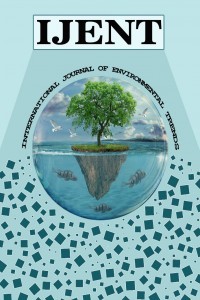Investigation of Environmental Quality of Yuvacik Dam Basin Groundwater and Surface Water Resources
Investigation of Environmental Quality of Yuvacik Dam Basin Groundwater and Surface Water Resources
Yuvacık basin surface and groundwater, water quality, Kocaeli.,
___
- [1] Gölbaşı S, Şen B. (2019). Atatürk Baraj Gölü’ne dökülen Kahta Çayı’nın (Adıyaman) su kalitesi. Su Ürünleri Dergisi; 36(4):1-1.
- [2] DSİ (T.C. Tarım Ve Orman Bakanlığı, Devlet Su İşleri Genel Müdürlüğü), 2019 Yılı Faaliyet Raporu, Sayfa 52, Ankara, 2020.
- [3] Karadavut İS., Saydam AC, Kalıpcı E, Karadavut S, Özdemir C. (2011). A Research for water pollution of Melendiz stream in terms of sustainability of ecological balance. Carpathian Journal of Earth and Environmental Sciences; 6(1):65-80.
- [4] Kalıpcı E, Cüce H, Toprak S. (2017). Coğrafi bilgi sistemleri (CBS) kullanılarak Mamasın barajı yüzey suyu kalitesinin değerlendirilmesi. Ömer Halisdemir Üniversitesi Mühendislik Bilimleri Dergisi; 6(2):351-361.
- [5] Kalıpcı E. (2019). Spatial analysis of water pollution by Geography Information Sytems (GIS) in Turkey. In:4nd International Conference on Material Science and Technology in Kızılcahamam (IMSTEC’19, 18-20 October 2019, Ankara/ TURKEY: Nevşehir Hacı Bektaş Veli University, p.806.
- [6] Kalıpcı E, Cüce H, Toprak S. (2017). Damsa Barajı (Nevşehir) yüzey suyu kalitesinin coğrafi bilgi sistemi ile mekânsal analizi. Karaelmas Science and Engineering Journal, 7(1):312-319.
- [7] Cüce H, Kalıpcı E, Taş B, Yılmaz M. (2020). Rakım farklılığı nedeniyle oluşan meteorolojik değişimlerin su kalitesine olan etkilerinin CBS ile değerlendirilmesi: morfolojik olarak farklı iki göl için bir karşılaştırma. Karadeniz Fen Bilimleri Dergisi, 10(1):1-26.
- [8] Ustaoğlu F, Tepe Y. (2019). Water quality and sediment contamination assessment of Pazarsuyu Stream, Turkey using multivariate statistical methods and pollution indicators. International Soil and Water Conservation Research, 7(1): 47-56.
- [9] Ustaoğlu F, Tepe Y, Taş B. (2020). Assessment of stream quality and health risk in a subtropical Turkey river system: a combined approach using statistical analysis and water quality index. Ecological Indicators, https ://doi.org/10.1016/j.ecoli nd.2019.105815.
- [10] Zengin M, Hızal A, Karakaş A, Serengil Y, Tuğrul D, Ercan M. (2005). İzmit yuvacık barajı su toplama havzasının yenilenebilir doğal kaynaklarının su üretimi (kalite, miktar ve rejim) amacıyla planlanması. Çevre ve Orman Bakanlığı Teknik Bülten, 197:2-40.
- [11] Anonim, Cemre Mühendislik Lab. İnş. San. ve Tic. Ltd. Şti., Yuvacık Barajı Havzası’nın Özel Hüküm Belirlemesine Esas Jeolojik ve Hidrojeolojik Etütü 2015, Cemre Mühendislik 01, Kocaeli, pp. 24-42.
- ISSN: 2602-4160
- Başlangıç: 2017
- Yayıncı: Muhammed Kamil ÖDEN
Hüseyin İNCE, Nuri ERDEM, Fazlı Engin TOMBUŞ, İbrahim Murat OZULU
IN SEMI-ARİD REGIONS PRODUCED VETCH OF YOUR PLANTS WATER STRESS REACTIONS
Kazım KUMAŞ, Ragıp YILDIRIM, Ali Özhan AKYÜZ
Heavy Metals in Soils Pb (Lead), Hg (Mercury), Cd (Cadmium), As (Arsenic) Effects on Human Health
Investigation of Environmental Quality of Yuvacik Dam Basin Groundwater and Surface Water Resources
Erkan KALIPCI, Selçuk VAROL, Hüseyin CÜCE
INVESTIGATION THE REMOVAL OF MALACHITE GREEN DYE FROM AQUEOUS SOLUTION BY USING SESAME SHELL
